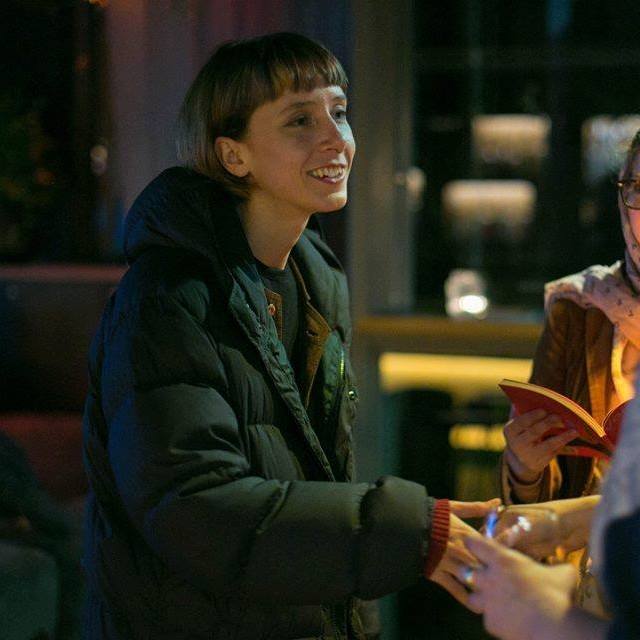Breathable Cities: How Urban Design Affects Respiration
• Illustration by Carla McRae
Words by Hollen Singleton
Illustrations by Carla McRae
This story is brought to you by our partner Activated Probiotics
Melbourne is the asthma capital of the world. So how does the way we design our cities affect their breathability?
With October, the Burkard volumetric air sampler comes out of hibernation. Housed on the roof of the University of Melbourne’s Earth Sciences building, this machine (looking like a cross between a wind turbine and a camping gas canister) sucks in the air around it like a vacuum. Between October and December, this machine and its brethren make a glass slide of particles for researchers to examine under a microscope, count the pollen grains and provide us with the Pollen Count. This is the most reliable predictor available to Melbourne’s urbanites for the presence of allergens in the air: microscopic catalysts for a familiar array of cold-like and respiratory symptoms. This is the main measure of the day-to-day breathability of Victoria’s urban heart.
Melbourne is now infamous for ‘asthma thunderstorms.’ On November 21, 2016, a clash of thunderstorms presented a gust front filled with aeroallergens (airborne pollutants and pollen). The high concentrations of pollen swirling downwards peaked at 6pm—a time when many in the urban centre were commuting homeward—to catastrophic effect. That fatal weather event (one that is not unique in Melbourne’s history) resulted in 8,500 emergency department attendees and nine deaths. The number of Victorian pollen-counting stations since that time has more than doubled with the increased awareness of breathability as a city concern.
So why does Melbourne, in particular, set off asthma? Many blame the much-loathed London plane trees. These trees are familiar to any visitor to the inner city—they make up three quarters of the city’s trees. They drop distinctive seed balls and their leaves are spined with fine white hairs called trichomes that fall in a cascade between October and December. This has led many to blame the introduced plane trees for their allergies, though studies have found that even among those who identified themselves as allergic to plane trees, only a quarter actually were. Much like the conspicuously bountiful wattle, it is their high visibility—their gaudy reproductive cycle—that leads many to point the finger.
The actual culprit appears to be grasses. The city is surrounded to the north and west by millions of hectares of grassland. Grass pollen is a super-light aeroallergen, meaning it can travel vast distances on the wind. When intact, the pollen from predominantly ryegrass (Lolium perenne) gets caught in the nose and throat: this causes hay fever. Melbourne’s notoriously changeable weather comes into play here. As the weather cycles from dry to wet, as in thunderstorms, the pollen grains burst and attach to diesel particles and can penetrate deeper into the lungs. It is these conditions—exceptionally plentiful pollen paired with thunderstorms—that seem to provoke the worst in asthma sufferers.
Traffic-related air pollution also appears to play a critical role in exacerbating asthma. While Melbourne’s air pollution levels are considered good by international standards, it appears that living within 200 metres of a major road tends to nullify these effects. Fuel combustion releases pollutants and particulates associated with asthma and other adverse health outcomes. Similarly, excess carbon dioxide appears to be both warming the planet and super-feeding plants to produce more pollen. The World Allergy Organisation published a statement declaiming this synergistic effect: the pollen season will be longer, earlier and more intense in years to come.
• Illustration by Carla McRae
There is, however, much that can be done in advance of the incoming changes. Melbourne’s air quality has steadily improved since the Environment Protection Authority started monitoring it in 1973. Awareness and attention to the threats of air pollution remains critical to making the kinds of city planning decisions Melbourne will need as the fourth fastest growing metropolis in the developed world.
In the last twenty years, there have been invented some stunning technological bridges in the realm of sustainable urban design. Architect Allison Dring began fighting air pollution in the 2000s with photo-catalytic titanium dioxide cladding—her façade for Mexico City’s Hospital Manuel Gea Gonzalez is reducing the street’s pollution by about 1000 cars per day. The CityTree designed by the German Green City Solutions is a wall of moss with the pollution-eating punch of hundreds of trees. Daan Roosegaarde and his team created the ‘Smog Free Tower’ (another giant outdoor air purifier), installed in Beijing in 2016. Studio Roosegaarde emphasises the beauty of their sustainable inventions, among which there is also a ‘Smog Free Ring’; the stone is made of hundreds of thousands of litres of pollution compressed inside a protective case. (Prince Charles owns a cufflinks version.) The dark particulate centre of these rings, if released and inhaled, is considered capable of shortening one’s lifespan by almost ten years.
While spectacular, these inventions are bridging technologies—compensations rather than cures. Dr. Ollie Cotsaftis of RMIT puts it this way: “We can of course design artefacts to capture pollens and pollutants in urban environments—which could be embedded into a building façade, for example—but maybe we also need to eliminate the problem at its cause.” Cities and nations need to pursue air pollution reduction as the primary solution for a breathable future.
Fuel combustion releases pollutants and particulates associated with asthma.
• Illustration by Carla McRae
Longer term approaches to dangerous traffic particulates include the improvement of public transport and planning roads around encouraging cyclists. Other options include the enforcement of non-vehicle zones and the expansion of green spaces (a 2015 study showed that greenery around schools enhanced children’s cognitive development). Some smaller solutions can help hay fever sufferers: urban planners’ tendency to plant male trees (for their reduced leaf litter) has meant a greater amount of allergenic pollen in the air. A simple sex change in the trees planted can make a big difference in the response of those walking in their shade.
Urban design that responds to changes in scientific knowledge about asthma can also improve outcomes. Repeated studies have shown that farm kids are far less likely to experience asthma (nine percent in comparison to the 19 percent in those raised in non-farming homes). In Holland and Germany, there are farms incorporating daycare centres. It appears to be farm dust, the prevalence of outdoor microbes, that lowers asthma rates. Agricultural environments could be woven into the urban landscape to reduce asthma in future generations of Melbourne’s kids. The Collingwood Children’s Farm, rather than a unique pocket of the urban landscape, could be a model space for expansion into other suburbs to reduce asthma risk in urban-born kids.
Melbourne is pursuing one highly popular goal: the gradual replacement of London plane trees with other tree species. They will make way for native species as well as drought- and heat-resistant introduced species. As with many climate change-related concerns, colonialist practices are an unavoidable undercurrent. Improved pasture grasses (those introduced grasses sown for productivity) are more allergenic than native grasses. European trees, such , oak, alder and privet were planted as a matter of aesthetic preference and are allergy triggers. (Introduced weeds pose similar problems, from the evocatively named ‘Paterson’s Curse’ to the more obvious ‘asthma weed.’) Pollen from native trees, on the other hand, is mainly dispersed by insects and birds and, as with the wattle, are shaped in such a way as to not go airborne.
The green spaces the city does possess, and those that must be newly minted, will be populated with largely native species, those adapted for this land (and less likely to provoke asthma in those who live here). Melbourne’s ongoing urban forest strategy emphasises diversity of species, with no particular tree allowed the predominance of the lane. As the climate continues to destabilise, biodiversity remains the best defence, as well as the most threatened resource. Urban design must take up every available tool, from encouraging carbon-neutral transport options in city planning and air-purifying materials in architecture to redesigning the landscape itself, enabling access to animals and native plants for the breathability of the inner city and every suburb.






